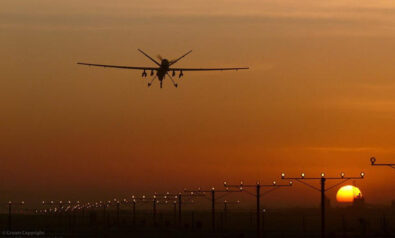Destabilisation in Yemen and Pakistan is tipping the scale in the wrong direction for the US drone warfare policy.
A highly controversial element of the war on terrorism, drones have led to troubling circumstances in both Pakistan and Yemen. Even as the US painstakingly sought to eliminate terror networks employing the smartest piece of its military technology over the past years, Washington’s high-frequency drone strike strategy has not only further destabilized both countries, ironically it has also aided a fresh spurt of anti-American terrorist outfits now threatening its security and national interests more than ever.
Drone strikes have become a staple of the new American century. Since their muted debut in Yemen on November 3, 2002, under George W. Bush, drone strikes have increased in frequency and scope. Thanks to a sympathetic audience in the administration of Barack Obama, the drone program has been expanded in both Pakistan and Yemen on a scale that has grown manifold in the past few years.
Reinventing its strategy of withdrawing ground troops while simultaneously boosting its air power – a ploy previously used by Richard Nixon in Vietnam – drones have come to define President Obama's military and counter-terrorism policy. Spurred by budgetary constraints, partly caused by costly wars in Afghanistan and Iraq,, drones have also greatly diminished the specter of combat troops arriving home in body bags.
However, Obama's military policy faces strategic failure amid growing global outrage over moral, legal and constitutional use of drones to eliminate terror threats. But more critically, the strategy is arguably proving counter-productive as drone strikes are now being increasingly linked with an explosion of anti-American sentiments and terrorist strikes in both Pakistan and Yemen.
In Pakistan, American drone strikes have reignited historical resentment simmering since the Zia-ul Haq era when Washington’s unceremonious loss of interest following Soviet departure from Afghanistan was seen as a betrayal by successive generations. In Yemen whose authoritarian government has traditionally always allied with the US, the outbreak of anti-American sentiments has been more pronounced than previously seen.
Pakistani Anti-Colonialism
Many Pakistanis view the strikes as a continuation of colonial manipulation in South Asia. To many, the sustained drone campaign inside Pakistan characteristically synchronizes with and reminiscent of the meddlesome and manipulative policies of the British rule before independence and thereafter America’s self-serving and selective support to Pakistan’s successive dictators especially during Soviet occupation of Afghanistan. The resentment has burned even more vigorously since the US-led coalition forces launched a military campaign in Afghanistan in the wake of 9/11 attacks throwing the sensitive political, social and cultural alignment between Pakistan and Afghanistan into disarray. Pashtun majority straddling the border along Pakistan’s treacherous tribal belt found itself increasingly cornered over questions of loyalty to its Afghan kinship and acquiescing to Islamabad, which has thrown its support behind the US in its war on terror. Pakistan’s decision to ally with Washington has severely divided the country in the wake of mounting civilian deaths in US-led missions both in Afghanistan and Pakistan. Most recently, the May 2011 Navy SEALS raid on Abbotabad was widely seen as a violation of Pakistan’s national sovereignty, and the Obama administration's constant demands on Pakistani military to move more decisively against the Taliban have been counterproductive.
Drone strikes are frequently used as a rhetorical device that reflects this festering bitterness, which is compounded by massive psychological damage and growing turbulence and conflict within Pakistan. This is apparent within affected areas, such as Peshawar, where populations have engaged in self-imposed curfews and other protective measures in order to maintain safety in the face of seemingly omnipresent strikes.
The effects of internal displacement of thousands of people, reduced to refugee status in their own country, are painfully visible in western Pakistan. The strikes, along with the fallout of a major 2005 earthquake, are driving large sections of Pakistan's Pashtun populations further south into metropolitan areas. This is especially true in the port city of Karachi, which is now nearly a quarter Pashtun. This confluence of residents into already crowded and tense urban environments has already begun to push the cities into further disarray.
Additionally, US drone strikes are creating an atmosphere of insecurity which, as an unintended consequence, is fuelling more conflict and violence between divergent groups in the society. As a result, Pakistan's northwestern regions have become more sympathetic to movements that support far-right interpretations of shariah (Islamic law). These movements often seek justice for the drone strikes by targeting the local “spies” who sell information to NATO. Within North and South Waziristan local populations have come to expect the horror of drone strikes to be echoed in militant raids and graphic video recordings of their executions.
In addition to these killings, sporadic violence has been directed at elements seen sympathetic of or subscribing to Western policies and values. Recent targets have included aid and relief workers, international health agencies running polio-eradication programs and even isolated attacks such as that on Malala Yusufzai, a young activist campaigning for girls’ education.
The Rise of Anti-Americanism in Yemen
Yemen has had a notably different reaction to the drone strikes. This is a result of its different history of foreign intervention. Though southern Yemen fought a bitter insurgency against the British colonial rule and their local allies during the Aden Emergency, this experience has not translated into a dominant anti-Western perspective.
Yemen's turbulent twentieth-century history owes more to Middle Eastern power struggles, such as those between former Egyptian military leader Gamal Abdul Nasser's government and the Saudi Royal Family during the North Yemeni civil war. Drone strikes in Yemen are therefore not part of a decades-long ideological showdown with former colonial masters, as they are seen to be in Pakistan.
Furthermore, drone strikes in Yemen differ from those in Pakistan in that US ties with Sana'a are far less wrinkled than those with Islamabad. Strikes have always occurred with full cooperation of the central Yemeni government, and unsurprisingly, the authoritarian regime in Sana'a has been greatly rewarded as a key ally in the war on terrorism. Since 2002, when strikes began, the US has relied on a strong alliance with Sana'a to conduct operations in the seemingly volatile and unstable country.
However, attitude of the Yemeni populace has shifted remarkably over the last 18 months, especially in the wake of Arab uprisings. Anti-American sentiments are on the rise and gaining momentum. The Obama administration, after shakily considering its options during the 2011 Yemeni Revolution, supported a marginally shifted autocratic regime as its new ally in the war on Al-Qaida in the Arabian Peninsula (AQAP), a militant Islamist group which led a seizure of large swaths of Yemeni territory during the revolution.
These US actions were driven mainly by concerns over AQAP's expansion. Revolutionaries fighting to oust President Ali Abdullah Saleh’s government viewed AQAP as a member of the lunatic fringe, and despite the militant group’s alarming growth, it still does not hold a popular position with the Yemeni people.
It has been argued that much of the territory seized in the summer of 2011 was arranged as such by then Yemeni President Ali Abdullah Saleh. The President and his associates withdrew combat units from southern provinces between April and June 2011, stationing them closer to Sana'a in order to strengthen the weakening government. The withdrawal crucially allowed militants to seize these vulnerable positions and thus prompt international worry.
This strategy led to the fall of the provincial capital of Zinjibar in May 2011, after which Obama took firmer action in support of limiting the revolutionary push. Saleh's scheme successfully painted the Yemeni Revolution as a force that could concede gains to AQAP.
This illusion had a drastic effect on US policy during the revolution quickly resulting in a drone strike that killed AQAP leader Anwar al-Awlaki and his 16-year-old son Abdul Rahman. It was strategically unnecessary as the group's influence on the Yemeni political scene was limited.
After Saleh agreed to a political transition in Yemen, the US and Saudi Arabia agreed to support Saleh's vice president, Abdu Rabbu Mansour Hadi, after a February 2012 presidential election in which he ran unopposed. Hadi then immediately ordered a military assault against the AQAP-controlled territories with US assistance, and a new partnership with Sana'a began.
As a result, Yemenis have become increasingly antagonistic towards the US. Discontented revolutionaries are bitter that the US and Saudi Arabia helped scupper a democratic revolution. Failure of Yemen’s ruling elite in stopping the targeted killings is further fuelling resentment amongst both the general populace and the victims of US drone strikes.
Many other Yemenis, who are already alienated by local class struggles and resource politics, find themselves beginning to mix anti-American sentiments with rhetoric against the Sana'a elite, who are themselves divided between Hadi supporters and Saleh loyalists.. The result is a growing anti-American attitude in much of the country.
The phenomenon is becoming particularly pronounced in southern Yemen where a fresh wave of secessionism has taken hold since military officers began labor strikes in 2007. The secessionists resent elite classes in Sana'a, to whom Saleh transferred southern industries (including its dwindling oil sector) after the 1994 civil war. Nationalist aspirations tied to these clashes have still not been addressed, which provides a breeding ground for far-right Islamist groups such as AQAP. An evolving AQAP that works in conjunction with separatists and other Islamist militants can easily begin to launch more sophisticated attacks.
Counterproductive Counterterrorism
Drone warfare has been given a mystique of super-efficient combat strategy with zero troop casualties due to drones' precision-attack capability. However, strikes occur within a political matrix that, for many decades, has seen the growth of Islamism as the only viable revolutionary alternative to oppressive nation-states. It is therefore curious that this political environment, which nurtures Islamic militarism, is the first to be ignored when combating that same militarism.
As the drone strikes continue to add to this matrix, it forms an unstable concoction, which is the perfect recipe for brewing radicalism.. Any serious push against terrorist organizations needs to bear this in mind as ongoing radicalization makes any productive end impossible.
The views expressed in this article are the author's own and do not necessarily reflect Fair Observer’s editorial policy.
Support Fair Observer
We rely on your support for our independence, diversity and quality.
For more than 10 years, Fair Observer has been free, fair and independent. No billionaire owns us, no advertisers control us. We are a reader-supported nonprofit. Unlike many other publications, we keep our content free for readers regardless of where they live or whether they can afford to pay. We have no paywalls and no ads.
In the post-truth era of fake news, echo chambers and filter bubbles, we publish a plurality of perspectives from around the world. Anyone can publish with us, but everyone goes through a rigorous editorial process. So, you get fact-checked, well-reasoned content instead of noise.
We publish 2,500+ voices from 90+ countries. We also conduct education and training programs
on subjects ranging from digital media and journalism to writing and critical thinking. This
doesn’t come cheap. Servers, editors, trainers and web developers cost
money.
Please consider supporting us on a regular basis as a recurring donor or a
sustaining member.
Will you support FO’s journalism?
We rely on your support for our independence, diversity and quality.







Comment